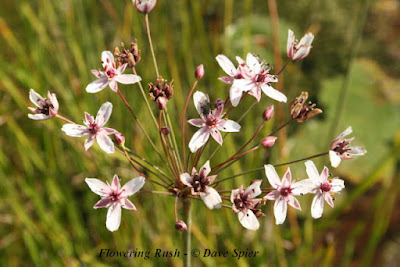The leaves of Flowering Rush are narrow, long-pointed and sword-like with parallel leaf veins, again similar to chives and other dicots, but it's somewhat misleading because Flowering Rush is in a plant family of its own. (In fact it's the only genus and species in that family.) It's capable of growing to a height of five feet, under the right conditions, with leaves up to 40 inches long. Most of the time it grows more in the one to four-foot height range.
Flowering Rush is an alien growing on muddy shores along the St. Lawrence Seaway and it has spread to Lake Champlain and the Great Lakes and beyond. It's a Eurasian species brought here as an ornamental in the early 1900's, and it continues to spread from Vermont to Washington and adjacent Canada.
The flowers are rather attractive with three pink and white petals alternating with three smaller pink sepals. In the center are nine pink-and-white male stamens in a radial pattern around six magenta female pistils.
Like all invasive species, it competes with desirable native wetland species, and once started, Flowering Rush is hard to irradicate because the trailing rhizomes spread under the mud and pea-sized bulbils detach, disperse in the water and quickly germinate into new plants. Varieties of this plant growing in the east also produce seeds that can spread on water currents.
There are many desirable native substitutes for Flowering Rush, including Sweet-flag, Northern Blue-flag, Pickerelweed, Giant Bur-reed, Lake Sedge, and Hardstem Bulrush. Blue-flag and Pickerelweed are attractive personal favorites.
Corrections, comments and questions are always welcome at northeastnaturalist@yahoo.com or you can connect through my Facebook page at Dave Spier (photographic naturalist) or my personal page, Dave Spier with the profile photo of me birding through a spotting scope. There's a new Fb page for The Northeast Naturalist.




No comments:
Post a Comment